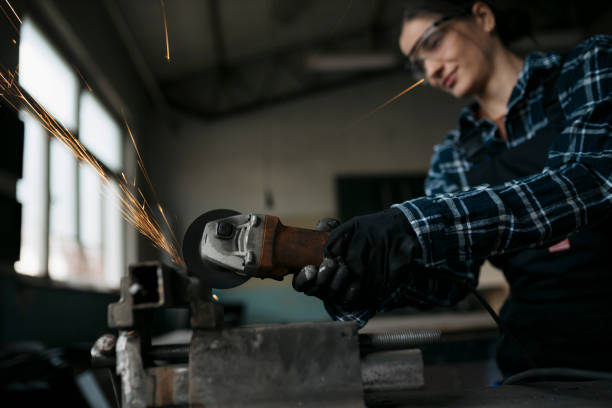Cutting discs, also known as cutting wheels or cut-off wheels, are essential tools in various industries, including metalworking, construction, and manufacturing. The performance of these discs directly affects the efficiency, quality, and cost-effectiveness of cutting operations. Measuring the performance of cutting discs involves evaluating several key parameters to ensure they meet specific requirements and deliver optimal results. This article delves into the critical aspects of measuring cutting disc performance, including cutting speed, disc longevity, precision, safety, and cost-effectiveness.
Cutting Speed
Cutting speed is a fundamental metric to measure the performance of cutting discs. It determines how quickly a disc can cut through a material, which directly impacts productivity. To measure cutting speed:
- Set up the Workpiece: Secure the material to be cut in a stable position. Ensure it is the same type and thickness for each test to maintain consistency.
- Operate the Cutting Tool: Use the cutting disc on a powered tool, such as an angle grinder, maintaining a consistent pressure and speed.
- Measure the Time: Start a timer as soon as the disc makes contact with the material and stop it once the cut is complete.
- Calculate the Speed:Divide the thickness of the material by the cutting time to determine the cutting speed in millimeters per second (mm/s).
Higher cutting speeds indicate a more efficient cutting disc, but it’s crucial to balance speed with other performance factors like precision and disc wear.
Disc Longevity
Disc longevity or lifespan is another critical performance metric. It refers to how long a cutting disc lasts before it needs to be replaced. To measure disc longevity:
- Initial Weight Measurement:Weigh the cutting disc before use to get its initial weight.
- Conduct Cutting Tests: Use the disc to perform a series of cuts on a standardized material.
- Monitor Performance:Regularly check the disc’s performance during the test, noting any decrease in cutting speed or increase in effort required.
- Final Weight Measurement:Weigh the disc after the tests to determine how much material has been worn away.
- Calculate Longevity:Divide the total amount of material cut by the weight loss of the disc to determine the disc’s wear rate.
Discs with slower wear rates and longer lifespans are generally more cost-effective and efficient for prolonged use.
Cutting Precision
Cutting precision is essential for applications requiring accurate and clean cuts. To evaluate precision:
- Prepare the Material: Use a workpiece with clear, straight lines marked for cutting.
- Perform the Cut: Use the cutting disc to follow the marked lines, maintaining a steady hand and consistent pressure.
- Evaluate the Cut:Inspect the cut edges for smoothness, straightness, and the presence of burrs or jagged edges.
- Measure Deviation:Use calipers or a micrometer to measure any deviation from the marked line.
A cutting disc that provides high precision will produce clean, straight cuts with minimal deviation, reducing the need for post-cut processing.
Safety
Safety is a paramount consideration when measuring cutting disc performance. A high-performing disc must not only cut efficiently but also do so safely. To assess safety:
- Check for Defects: Inspect the disc for any visible defects such as cracks, chips, or uneven surfaces before use.
- Test Under Load: Use the disc under normal operating conditions and monitor for any signs of instability or breakage.
- Evaluate Vibration:Measure the level of vibration during cutting, as excessive vibration can indicate potential safety issues and cause operator fatigue.
- Monitor Heat Generation:Check the amount of heat generated during cutting. Excessive heat can weaken the disc and the material being cut, posing a safety risk.
Using a cutting disc that maintains structural integrity under stress and produces minimal vibration and heat enhances both operator safety and cutting performance.
Cost-Effectiveness
Cost-effectiveness involves evaluating the overall value provided by the cutting disc in terms of cost per cut. To measure cost-effectiveness:
- Calculate the Cost per Disc:Determine the purchase cost of the cutting disc.
- Measure Total Cuts: Record the total number of cuts made by the disc before it needs replacement.
- Assess Performance Factors: Consider factors such as cutting speed, longevity, and precision.
- Calculate Cost per Cut:Divide the cost of the disc by the total number of cuts to determine the cost per cut.
A cutting disc that offers a lower cost per cut, while maintaining high performance in other areas, provides better value for money.
Material Compatibility
Material compatibility is crucial for determining the effectiveness of a cutting disc across different types of materials. To evaluate this:
- Test on Various Materials: Use the cutting disc on different materialssuch as steel, aluminum, and stainless steel.
- Measure Performance Metrics:Record cutting speed, precision, and disc wear for each material type.
- Compare Results: Assess how well the disc performs across different materials, noting any significant differences in performance.
A versatile cutting disc that performs well on a range of materials can reduce the need for multiple types of discs, improving efficiency and reducing costs.
Heat Resistance
Heat resistance affects both the performance and safety of cutting discs. Excessive heat can lead to disc failure and affect the quality of the cut. To measure heat resistance:
- Thermocouple Measurement: Attach a thermocouple to the cutting area to monitor the temperature during cutting.
- Cutting Tests: Perform cutting tests on a standardized material.
Record Temperatures: Note the temperatures reached during cutting.
- Assess Disc Integrity: Check for any signs of disc degradation or performance loss at high temperatures.
A cutting disc with good heat resistance will maintain its performance and structural integrity even under high-temperature conditions.
User Comfort
User comfort is an often-overlooked aspect of cutting disc performance but plays a significant role in long-term usability. To assess user comfort:
- Vibration Analysis:Measure the level of vibration transmitted to the user during cutting.
- Noise Levels: Record the noise levels produced by the cutting operation.
- Ease of Handling: Evaluate the ease of disc installation, balance, and overall handling during cutting.
Discs that provide low vibration, minimal noise, and ease of use contribute to better user comfort and reduced operator fatigue.
Environmental Impact
Environmental impact is becoming increasingly important in the evaluation of cutting tools. To assess the environmental impact:
- Material Composition: Review the materials used in the disc, prioritizing those that are eco-friendly or recyclable.
- Dust and Emissions: Measure the amount of dust and emissions produced during cutting.
- Lifespan and Waste:Consider the longevity of the disc and the amount of waste generated by worn-out discs.
Cutting discs with lower environmental impact contribute to sustainable practices and reduce the overall carbon footprint.
Conclusion
Measuring the performance of cutting discs involves a comprehensive evaluation of various factors, including cutting speed, disc longevity, precision, safety, cost-effectiveness, material compatibility, heat resistance, user comfort, and environmental impact. By systematically assessing these parameters, users can select the most suitable cutting discs for their specific applications, ensuring optimal performance, safety, and value. A well-chosen cutting disc not only enhances productivity but also contributes to better quality and cost-efficiency in cutting operations.


